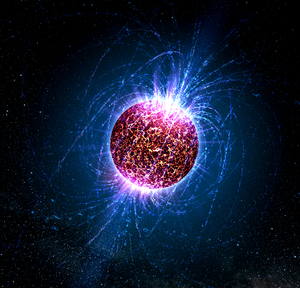Difference between revisions of "Neutron Star"
(Created page with "==Key Stage 4== right|300px|thumb|An artist's impression of a '''neutron star''' with [[plasma streaming in arcs due to the extremely intense Magnet...") |
|||
| Line 7: | Line 7: | ||
: After a [[High Mass Star|high mass star]] has gone [[supernova]] the core which remains is crushed so much that the [[atom]]s [[Nuclear Fusion|fuse]] together and all [[proton]]s turn into [[neutron]]s making one single [[atom]] made of [[neutron]]s. | : After a [[High Mass Star|high mass star]] has gone [[supernova]] the core which remains is crushed so much that the [[atom]]s [[Nuclear Fusion|fuse]] together and all [[proton]]s turn into [[neutron]]s making one single [[atom]] made of [[neutron]]s. | ||
: A '''neutron star''' is around 20km in [[diameter]]. | : A '''neutron star''' is around 20km in [[diameter]]. | ||
| + | |||
| + | ===Beyond the Curriculum=== | ||
| + | {{#ev:youtube|https://www.youtube.com/watch?v=fFeV8WxIZLk}} | ||
Revision as of 18:06, 19 April 2019
Key Stage 4

An artist's impression of a neutron star with plasma streaming in arcs due to the extremely intense magnetic field.
Meaning
A neutron star is one of the possible last stages of a high mass star's life in which the core has collapsed so much that it has become a single atom made of only neutrons.
About Neutron Stars
- After a high mass star has gone supernova the core which remains is crushed so much that the atoms fuse together and all protons turn into neutrons making one single atom made of neutrons.
- A neutron star is around 20km in diameter.